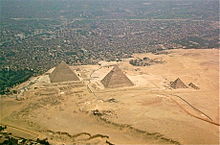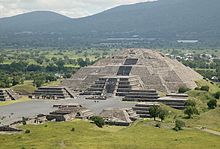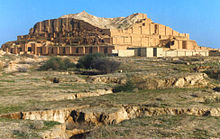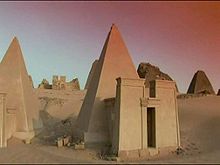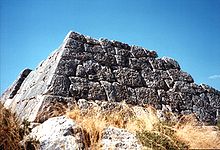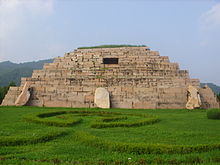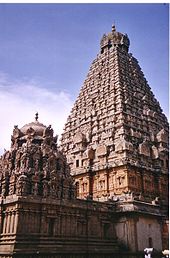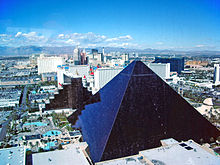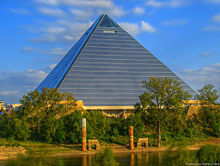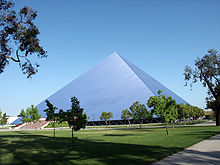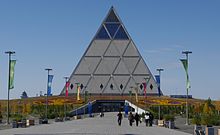
Pyramid
Background to the schools Wikipedia
This wikipedia selection has been chosen by volunteers helping SOS Children from Wikipedia for this Wikipedia Selection for schools. SOS Children has looked after children in Africa for forty years. Can you help their work in Africa?
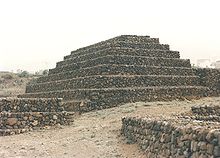
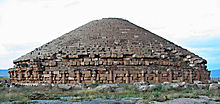
A pyramid (from Greek: πυραμίς pyramis) is a structure whose shape is roughly that of a pyramid in the geometric sense; that is, its outer surfaces are triangular and converge to a single point at the top. The base of a pyramid can be trilateral, quadrilateral, or any polygon shape, meaning that a pyramid has at least three outer triangular surfaces (at least four faces including the base). The square pyramid, with square base and four triangular outer surfaces, is a common version.
A pyramid's design, with the majority of the weight closer to the ground, and with the pyramidion on top means that less material higher up on the pyramid will be pushing down from above. This distribution of weight allowed early civilizations to create stable monumental structures.
Pyramids have been built by civilizations in many parts of the world. For thousands of years, the largest structures on Earth were pyramids—first the Red Pyramid in the Dashur Necropolis and then the Great Pyramid of Khufu, both of Egypt, the latter the only one of the Seven Wonders of the Ancient World still remaining. Khufu's Pyramid is built mainly of limestone (with large red granite blocks used in some interior chambers), and is considered an architectural masterpiece. It contains around 1,300,000 blocks ranging in weight from 2.5 tonnes (5,500 lb) to 15 tonnes (33,000 lb) and is built on a square base with sides measuring about 230 m (755 ft), covering 13 acres. Its four sides face the four cardinal points precisely and it has an angle of 52 degrees. The original height of the Pyramid was 146.5 m (488 ft), but today it is only 137 m (455 ft) high, the 9 m (33 ft) that is missing is due to the theft of the fine quality white Tura limestone covering, or casing stones, for construction in Cairo. It is still the tallest pyramid. The largest pyramid by volume is the Great Pyramid of Cholula, in the Mexican state of Puebla.
Ancient monuments
Mesopotamia
The Mesopotamians built the earliest pyramidal structures, called ziggurats. In ancient times, these were brightly painted. Since they were constructed of sun-dried mud-brick, little remains of them. Ziggurats were built by the Sumerians, Babylonians, Elamites, Akkadians, and Assyrians for local religions. Each ziggurat was part of a temple complex which included other buildings. The precursors of the ziggurat were raised platforms that date from the Ubaid period during the fourth millennium BCE. The earliest ziggurats began near the end of the Early Dynastic Period. The latest Mesopotamian ziggurats date from the 6th century BCE. Built in receding tiers upon a rectangular, oval, or square platform, the ziggurat was a pyramidal structure with a flat top. Sun-baked bricks made up the core of the ziggurat with facings of fired bricks on the outside. The facings were often glazed in different colors and may have had astrological significance. Kings sometimes had their names engraved on these glazed bricks. The number of tiers ranged from two to seven. It is assumed that they had shrines at the top, but there is no archaeological evidence for this and the only textual evidence is from Herodotus. Access to the shrine would have been by a series of ramps on one side of the ziggurat or by a spiral ramp from base to summit. The Mesopotamian ziggurats were not places for public worship or ceremonies. They were believed to be dwelling places for the gods and each city had its own patron god. Only priests were permitted on the ziggurat or in the rooms at its base, and it was their responsibility to care for the gods and attend to their needs. The priests were very powerful members of Sumerian society.
Egypt
The most famous pyramids are the Egyptian pyramids — huge structures built of brick or stone, some of which are among the world's largest constructions. They are shaped as a reference to the rays of the sun. Most pyramids had a polished, highly reflective white limestone surface, in order to give them a shining appearance when viewed from a distance. The capstone was usually made of hard stone - granite or basalt - and could be plated with gold, silver, or electrum and would also be highly reflective.
After 2700 BCE, the Egyptians began building pyramids, until about 1700 BCE. The first pyramid was built during the Third Dynasty by king Djoser and his architect Imhotep, as a step pyramid by stacking six mastabas. The largest Egyptian pyramids are the pyramids at Giza. "The Egyptian sun god Ra, considered the father of all pharaohs, was said to have created himself from a pyramid-shaped mound of earth before creating all other gods. The pyramid’s shape is thought to have symbolized the sun’s rays" (Donald B. Redford, Ph.D., Penn State).
The age of the pyramids reached its zenith at Giza in 2575-2150 BCE. Ancient Egyptian pyramids were in most cases placed western of the river Nile because the divine pharaoh’s soul was meant to join with the sun during its descent before continuing with the sun in its eternal round.
As of 2008, some 135 pyramids have been discovered in Egypt. The Great Pyramid of Giza is the largest in Egypt and one of the largest in the world. Until Lincoln Cathedral was finished in CE 1311, it was the tallest building in the world. The base is over 52,600 square metres (566,000 sq ft) in area. While pyramids are associated with Egypt, the nation of Sudan has 220 extant pyramids, the most numerous in the world.
The Great Pyramid of Giza is one of the Seven Wonders of the Ancient World. It is the only one to survive into modern times. The Ancient Egyptians covered the faces of pyramids with polished white limestone, containing great quantities of fossilized seashells. Many of the facing stones have fallen or have been removed and used for construction in Cairo.

Most pyramids are located near Cairo, with only one royal pyramid being located south of Cairo, at the Abydos temple complex. The pyramid at Abydos, Egypt were commissioned by Ahmose I who founded the 18th Dynasty and the New Kingdom.
The building of pyramids began in the Third Dynasty with the reign of King Djoser. Early kings such as Snefru built several pyramids, with subsequent kings adding to the number of pyramids until the end of the Middle Kingdom. The last king to build royal pyramids was Ahmose, with later kings hiding their tombs in the hills, like in the Valley of the Kings in Luxor's West Bank.
In Medinat Habu, or Deir el-Medina, smaller pyramids were built by individuals. Smaller pyramids were also built by the Nubians who ruled Egypt in the Late Period, though their pyramids had steeper sides.
Sudan
Nubian pyramids were constructed (roughly 220 of them) at three sites in Sudan to serve as tombs for the kings and queens of Napata and Meroë. The pyramids of Kush, also known as Nubian Pyramids, have different characteristics than the pyramids of Egypt. The Nubian pyramids were constructed at a steeper angle than Egyptian ones. They were monuments to dead kings and queens. Pyramids were still being built in Sudan as late as CE 300.
Nigeria
One of the unique structures of Igbo culture was the Nsude Pyramids, at the Nigerian town of Nsude, in Abuja, northern Igboland. Ten pyramidal structures were built of clay/mud. The first base section was 60 ft. in circumference and 3 ft. in height. The next stack was 45 ft. in circumference. Circular stacks continued, till it reached the top. The structures were temples for the god Ala/ Uto, who was believed to reside at the top. A stick was placed at the top to represent the god's residence. The structures were laid in groups of five parallel to each other. Because it was built of clay/mud like the Deffufa of Nubia, time has taken its toll requiring periodic reconstruction.
Greece
Pausanias (2nd century CE) mentions two buildings resembling pyramids, one, 19 kilometres (12 mi) southwest of the still standing structure at Hellenikon, a common tomb for soldiers who died in a legendary struggle for the throne of Argos and another which he was told was the tomb of Argives killed in a battle around 669/8 BCE. Neither of these still survive and there is no evidence that they resembled Egyptian pyramids.
There are also at least two surviving pyramid-like structures still available to study, one at Hellenikon and the other at Ligourio/Ligurio, a village near the ancient theatre Epidaurus. These buildings were not constructed in the same manner as the pyramids in Egypt. They do have inwardly sloping walls but other than those there is no obvious resemblance to Egyptian pyramids. They had large central rooms (unlike Egyptian pyramids) and the Hellenikon structure is rectangular rather than square, 12.5 by 14 metres (41 by 46 ft) which means that the sides could not have met at a point. The stone used to build the pyramids was limestone quarried locally and was cut to fit, not into freestanding blocks like the Great Pyramid of Giza.
There are no remains or graves in or near the structures. Instead, the rooms that the walls housed were made to be locked from the inside. This coupled with the platform roof, means that one of the functions these structures could have served was as watchtowers. Another possibility for the buildings is that they are shrines to heroes and soldiers of ancient times, but the lock on the inside makes no sense for such a purpose.
The dating of these "pyramids" has been made from the pot shards excavated from the floor and on the grounds. The latest dates available from scientific dating have been estimated around the 5th and 4th centuries. Normally this technique is used for dating pottery, but here researchers have used it to try to date stone flakes from the walls of the structures. This has created some debate about whether or not these "pyramids" are actually older than Egypt, which is part of the Black Athena controversy. The basis for their use of thermoluminescence in order to date these structures is a new method of collecting samples for testing. Scientists from laboratories hired out by the recent excavators of the site, The Academy of Athens, say that they can use the electrons trapped on the inner surface of the stones to positively identify the date that the stones were quarried and put together.
Mary Lefkowitz has criticised this research. She suggests that some of the research was done not to determine the reliability of the dating method, as was suggested, but to back up an assumption of age and to make certain points about pyramids and Greek civilization. She notes that not only are the results not very precise, but that other structures mentioned in the research are not in fact pyramids, e.g. a tomb alleged to be the tomb of Amphion and Zethus near Thebes, a structure at Stylidha (Thessaly) which is just a long wall, etc. She also notes the possibility that the stones that were dated might have been recycled from earlier constructions. She also notes that earlier research from the 1930s, confirmed in the 1980s by Fracchia was ignored. She argues that they undertook their research using a novel and previously untested methodology in order to confirm a predetermined theory about the age of these structures.
Liritzis responded in a journal article published in 2011, stating that Lefkowitz failed to understand and misinterpreted the methodology.
Spain
The Pyramids of Güímar refer to six rectangular pyramid-shaped, terraced structures, built from lava stone without the use of mortar. They are located in the district of Chacona, part of the town of Güímar on the island of Tenerife in the Canary Islands. The structures have been dated to the 19th century and their original function explained as a byproduct of contemporary agricultural techniques.
Local traditions as well as surviving images indicate that similar structures (also known as, "Morras", "Majanos", "Molleros", or "Paredones") could once have been found in many locations on the island. However, over time they have been dismantled and used as a cheap building material. In Güímar itself there were nine pyramids, only six of which survive.
China
There are many square flat-topped mound tombs in China. The First Emperor Qin Shi Huang (circa 221 BCE, who unified the 7 pre-Imperial Kingdoms) was buried under a large mound outside modern day Xi'an. In the following centuries about a dozen more Han Dynasty royals were also buried under flat-topped pyramidal earthworks.
Mesoamerica
A number of Mesoamerican cultures also built pyramid-shaped structures. Mesoamerican pyramids were usually stepped, with temples on top, more similar to the Mesopotamian ziggurat than the Egyptian pyramid.
The largest pyramid by volume is the Great Pyramid of Cholula, in the Mexican state of Puebla. This pyramid is considered the largest monument ever constructed anywhere in the world, and is still being excavated. The third largest pyramid in the world, the Pyramid of the Sun, at Teotihuacan is also located in Mexico. There is an unusual pyramid with a circular plan at the site of Cuicuilco, now inside Mexico City and mostly covered with lava from an eruption of the Xitle Volcano in the 1st century BCE. There are several circular stepped pyramids called Guachimontones in Teuchitlán, Jalisco as well.
Pyramids in Mexico were often used as places of human sacrifice. For the re-consecration of Great Pyramid of Tenochtitlan in 1487, the Aztecs reported that they sacrificed about 80,400 people over the course of four days.
North America
Many pre-Columbian Native American societies of ancient North America built large pyramidal earth structures known as platform mounds. Among the largest and best-known of these structures is Monks Mound at the site of Cahokia, which has a base larger than that of the Great Pyramid at Giza. Many of the mounds underwent multiple episodes of mound construction at periodic intervals, some becoming quite large. They are believed to have played a central role in the mound-building peoples' religious life and documented uses include semi-public chief's house platforms, public temple platforms, mortuary platforms, charnel house platforms, earth lodge/town house platforms, residence platforms, square ground and rotunda platforms, and dance platforms. Cultures who built substructure mounds include the Troyville culture, Coles Creek culture, Plaquemine culture and Mississippian cultures.
Roman Empire
The 27-metre-high Pyramid of Cestius was built by the end of the 1st century BCE and still exists today, close to the Porta San Paolo. Another one, named Meta Romuli, standing in the Ager Vaticanus (today's Borgo), was destroyed at the end of the 15th century.
There is also a Roman era pyramid built in Falicon, France. There were many more pyramids built in France in this period.
Medieval Europe
Pyramids have occasionally been used in Christian architecture of the feudal era, e.g. as the tower of Oviedo's Gothic Cathedral of San Salvador.
India
Many giant granite temple pyramids were made in South India during the Chola Empire, many of which are still in religious use today. Examples of such pyramid temples include Brihadisvara Temple at Thanjavur, the Temple of Gangaikondacholapuram and the Airavatesvara Temple at Darasuram. However the largest temple pyramid in the area is Sri Rangam in Srirangam, Tamil Nadu. The Thanjavur temple was built by Raja raja Chola in 11th century. The Brihadisvara Temple was declared by UNESCO as a World Heritage Site in 1987; the Temple of Gangaikondacholapuram and the Airavatesvara Temple at Darasuram were added as extensions to the site in 2004.
Indonesia
Next to menhir, stone table, and stone statue; Austronesian megalithic culture in Indonesia also featured earth and stone step pyramid structures called Punden Berundak as discovered in Pangguyangan, Cisolok and Gunung Padang, West Java. The construction of stone pyramids is based on the native beliefs that mountains and high places are the abode for the spirit of the ancestors.
The step pyramid is the basic design of 8th century Borobudur Buddhist monument in Central Java. However the later temples built in Java were influenced by Indian Hindu architecture, as displayed by the towering spires of Prambanan temple. In the 15th century Java during late Majapahit period saw the revival of Austronesian indigenous elements as displayed by Sukuh temple that somewhat resemble Mesoamerican pyramid.
Peru
- Caral
- Túcume
Modern pyramids

- The Louvre Pyramid in Paris, France, in the court of the Louvre Museum, is a 20.6 meter (about 70 foot) glass structure which acts as an entrance to the museum. It was designed by the American architect I. M. Pei and completed in 1989.
- The Luxor Hotel in Las Vegas, United States, is a 30-story true pyramid with light beaming from the top.
- The 32-story Pyramid Arena in Memphis, Tennessee (a city named after the ancient Egyptian capital whose name itself was derived from the name of one of its pyramids). Built in 1991, it was the home court for the University of Memphis men's basketball program, and the National Basketball Association's Memphis Grizzlies until 2004.
- The Walter Pyramid, home of the basketball and volleyball teams of the California State University, Long Beach, campus in California, United States, is an 18-story-tall blue true pyramid.
- The 48-story Transamerica Pyramid in San Francisco, California, designed by William Pereira, one of the city's symbols.
- The 105-story Ryugyong Hotel in Pyongyang, Northern Korea.
- A former museum/monument in Tirana, Albania is commonly known as the "Pyramid of Tirana." It differs from typical pyramids in having a radial rather than square or rectangular shape, and gently sloped sides that make it short in comparison to the size of its base.
- The Slovak Radio Building in Bratislava, Slovakia. This building is shaped like an inverted pyramid.
- The Summum Pyramid, a 3 story pyramid in Salt Lake City, Utah, used for instruction in the Summum philosophy and conducting rites associated with Modern Mummification.
- The Palace of Peace and Reconciliation in Astana, Kazakhstan.
- The Pyramids at Osho Commune in Pune, India (for meditation purposes).
- The three pyramids of Moody Gardens in Galveston, Texas.
- The Co-Op Bank Pyramid or Stockport Pyramid in Stockport, England is a large pyramid-shaped office block in Stockport in England. (The surrounding part of the valley of the upper Mersey has sometimes been called the "Kings Valley" after the Valley of the Kings in Egypt.)
- The Ames Monument in southeastern Wyoming honoring the brothers who financed the Union Pacific Railroad.
- The Ballandean Pyramid, at Ballandean in rural Queensland is a 15 meter folly pyramid made from blocks of local granite.
- The Karlsruhe Pyramid is a pyramid made of red sandstone, located in the centre of the market square of Karlsruhe, Germany. It was erected in the years 1823–1825 over the vault of the city's founder, Margrave Charles III William (1679–1738).
- The GoJa Music Hall in Prague.
- The Muttart Conservatory greenhouses in Edmonton, Alberta.
- Small pyramids similar to those of the Louvre can be found outside the lobby of the Citicorp Building in Long Island City, Queens NY.
- The Pyramids of the City Stars Complex in Cairo, Egypt.
- Pyramid building belonging to The Digital Group (TDG), at Hinjwadi, Pune, India.
- The Steelcase Corporate Development Centre near Grand Rapids, Michigan.
- Sunway Pyramid shopping mall in Selangor, Malaysia.
- Hanoi Museum with an overall design of a reversed Pyramid.
- The Pyramide des Ha! Ha! by artist Jean-Jules Soucy fr:Jean-Jules Soucy in La Baie, Quebec is made out of 3 000 give way signs.
- The "Pyramid" culture-entertainment complex and Monument of Kazan siege (Church of Image of Edessa) in Kazan, Russia.
- The "Phorum" of Expocentre business-exhibition complex in Moscow, Russia.
- Few pyramids of the Marco-city shopping-entertainment complex in Vitebsk, Belarus.
- The Time pyramid in Wemding, Germany, a pyramid begun in 1993 and scheduled for completion in the year 3183.
- Triangle, a proposed skyscraper in Paris.
- The Shimizu Mega-City Pyramid, a proposed project for construction of a massive pyramid over Tokyo Bay in Japan.
- The tomb of Quintino Sella, outside the monumental cemetery of Oropa.
